Geneviève “Ginette” Lantelme (born 1883) was a French stage actress, socialite, fashion icon, and courtesan.

Geneviève Lantelme, ca. 1900s via

Geneviève “Ginette” Lantelme (born 1883) was a French stage actress, socialite, fashion icon, and courtesan.

Geneviève Lantelme, ca. 1900s via
Jacques Henri Lartigue (1894 – 1986) was a French photographer and painter, known for his photographs of automobile races, planes and female Parisian fashion models

Jacques-Henri Lartigue, Avenue du Bois de Boulogne, Paris, 1911 via

Jacques Henri Lartigue, Avenue du Bois de Boulogne, Paris, 1911 via

Jacques Henri Lartigue, Bois de Boulogne, 1911 © Ministère de la Culture – France / AAJHL via
Princess Marie Bonaparte Princess George of Greece and Denmark (1882-1962) known as Princess George of Greece and Denmark upon her marriage, was a French author and psychoanalyst, closely linked with Sigmund Freud.
Her wealth contributed to the popularity of psychoanalysis, and enabled Freud’s escape from Nazi Germany. Marie Bonaparte was a great-grandniece of Emperor Napoleon I of France. She was the only child of Prince Roland Bonaparte (19 May 1858 – 14 April 1924) and Marie-Félix Blanc (1859–1882).
Her paternal grandfather was Prince Pierre Napoleon Bonaparte, son of Prince Lucien Bonaparte, who was one of Napoleon’s rebellious and disinherited younger brothers. For this reason, despite her title Marie was not a member of the dynastic branch of the Bonapartes who claimed the French imperial throne from exile.
Her maternal grandfather was François Blanc, the principal real-estate developer of Monte Carlo. It was from this side of her family that Marie inherited her great fortune.
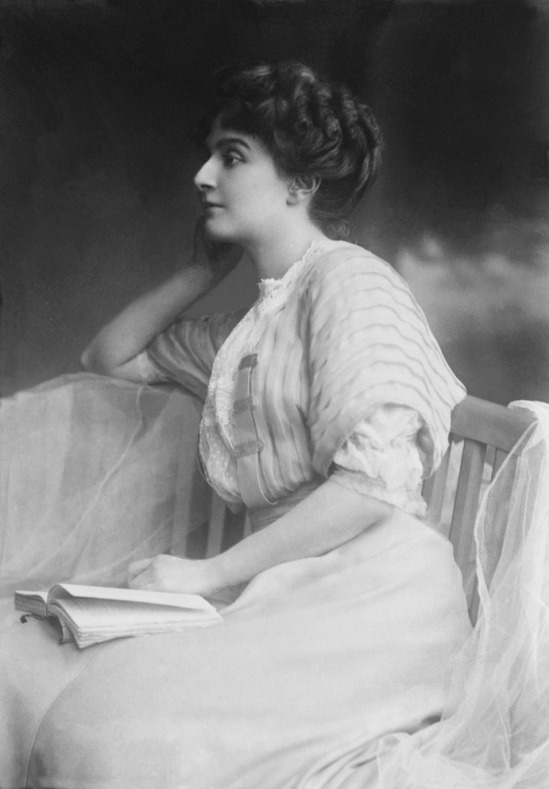
Marie Bonaparte via
Henri Manuel (1874 – 1947 was a Parisian photographer who served as the official photographer of the French government from 1914 to 1944.
In 1900, Manuel opened a portrait studio in Paris with his brother Gaston, which specialised in portraitphotography. Manuel quickly became renowned as a photographer of people from the worlds of politics, art and sports, as well as a photographer of art and architecture. Soon his portraits were used by news agencies, and in 1910 Manuel’s studio began providing a commercial service to news agencies for photographs known as “l’Agence universelle de reportage Henri Manuel”.
The studio became the largest photographic studio in Paris and a leading centre where young aspiring photographers such as Thérèse Bonney might go to work.
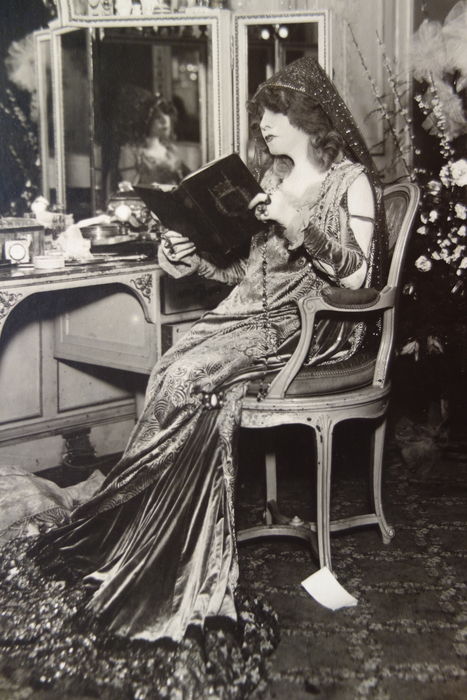
Sarah Bernhardt by Henri Manuel via

Genevieve Lantelme by Henri Manuel via

Régina Badet by Henri Manuel, c. 1910 via

Marie Curie in her laboratoire, 1912 via

Denise Poiret by Henri Manuel, 1910s via

Colette by Henri Manuel, 1900s via

Fashion photograph by Henri Manuel, 1895 via

Geneviève Lantelme circa 1900 via
In 1911, publisher Lucien Vogel dared photographer Edward Steichen to promote fashion as a fine art in his work. Steichen responded by snapping photos of gowns designed by leading French fashion designer Paul Poiret, hauntingly backlit and shot at inventive angles.
The photographs were published in the April 1911 issue of the magazine Art et Décoration. According to historian Jesse Alexander, the occasion is:
“now considered to be the first ever modern fashion photography shoot,”
The garments were imaged as much for their artistic quality as their formal appearance

Edward Steichen, L’Art de la Robe by Paul Poiret in Art et Décoration, 1911 via

Edward Steichen, L’Art de la Robe by Paul Poiret in Art et Décoration, 1911 via

Edward Steichen, L’Art de la Robe by Paul Poiret in Art et Décoration, 1911 via

Edward Steichen, L’Art de la Robe by Paul Poiret in Art et Décoration, 1911 via
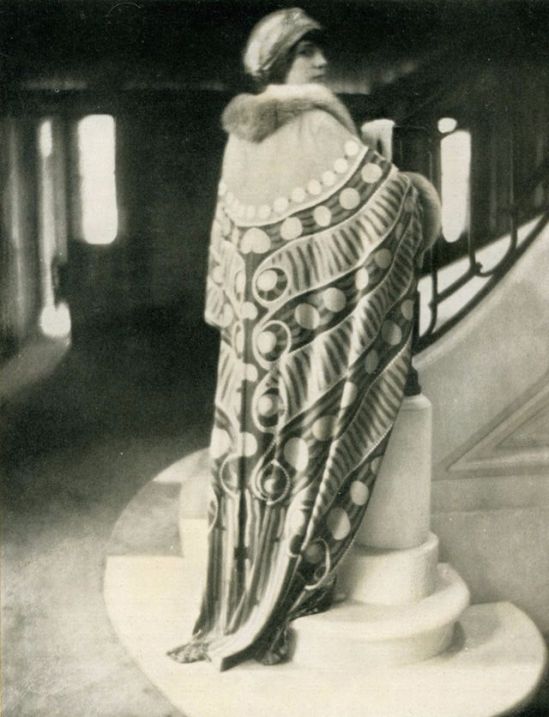
Edward Steichen, L’Art de la Robe by Paul Poiret in Art et Décoration, 1911 via

Edward Steichen, L’Art de la Robe by Paul Poiret in Art et Décoration, 1911 via

Edward Steichen, L’Art de la Robe by Paul Poiret in Art et Décoration, 1911 via

Edward Steichen, L’Art de la Robe by Paul Poiret in Art et Décoration, 1911 via

Edward Steichen, L’Art de la Robe by Paul Poiret in Art et Décoration, 1911 via
Jeanne Margaine-Lacroix has been neglected by fashion historians. She inherited her couture house from her mother Mme. Margaine, in 1899. The following year she changed the name to Margaine-Lacroix.
She influenced the new slender line of fashion. She was famous for her revolutionary corsetless dresses and her ground-breaking front-lacing corsets. In the 1900s, Paris was the fashion capital of the world. Couturiers routinely sent mannequins to the racecourse, wearing their latest designs. Her models caused a sensation at Longchamp in 1908.
Three mannequins walked onto the racecourse dressed in blue, white and havane brown creations by Margaine-Lacroix. According to newspapers, spectators called the three women a “monstrosity”, accused them of being semi-naked and showing revolting décolletage .
However, soon women everywhere were wearing dresses after Margaine-Lacroix’s design.
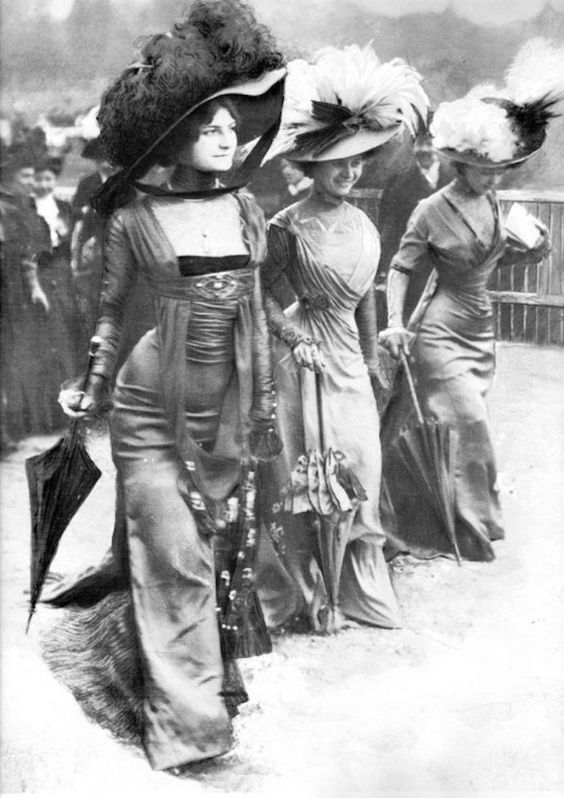
In the Spring of 1908, three women walked onto the Longchamp racecourse in Paris and caused a scandal by the semi-naked clothes they were wearing via

Longchamp racecourse, Paris 1908 via

Tanagréenne back drape on Sylphide dress by Jeanne Margaine-Lacroix. Here is an example of her slender, corsetless line, the robe-tanagréenne. It is worn by her favourite model, who small bust and simple hairstyle were avant-garde for the time and contrasted strongly with the generally accepted ideals of fashionable feminine beauty in the first decade of the twentieth-century, 1908 via

Sylphide dress with Tanagréenne back drape by Jeanne Margaine-Lacroix, 1908 via

Margaine-Lacroix mannequins pictured in the Parc de Vincennes in March 1910, wearing the new jupe-culotte – an early version of trousers via
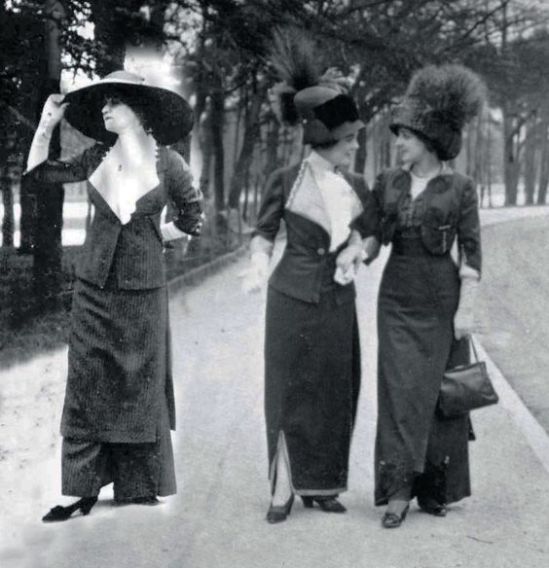
March 1910. Margaine-Lacroix mannequins in the new jupe-culotte via